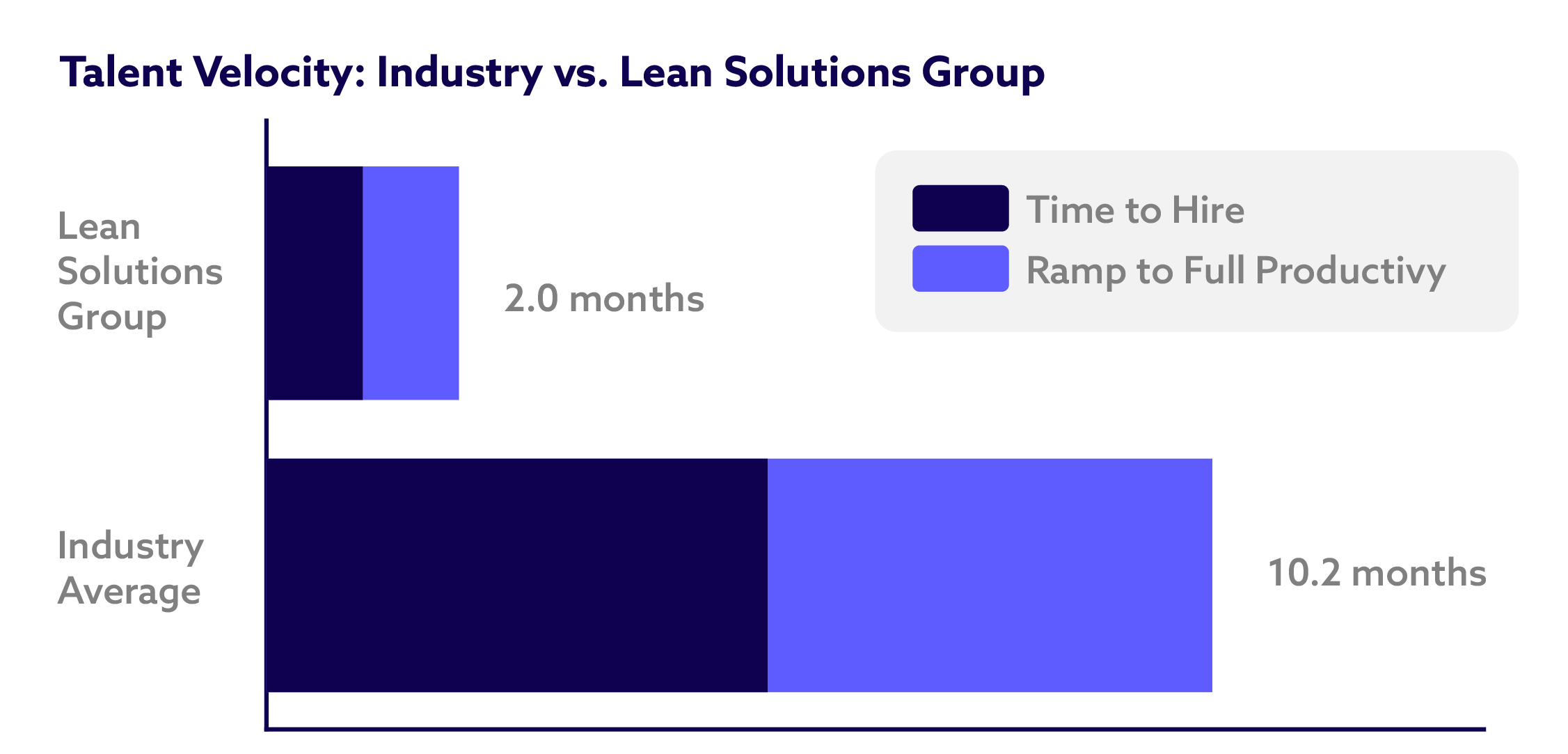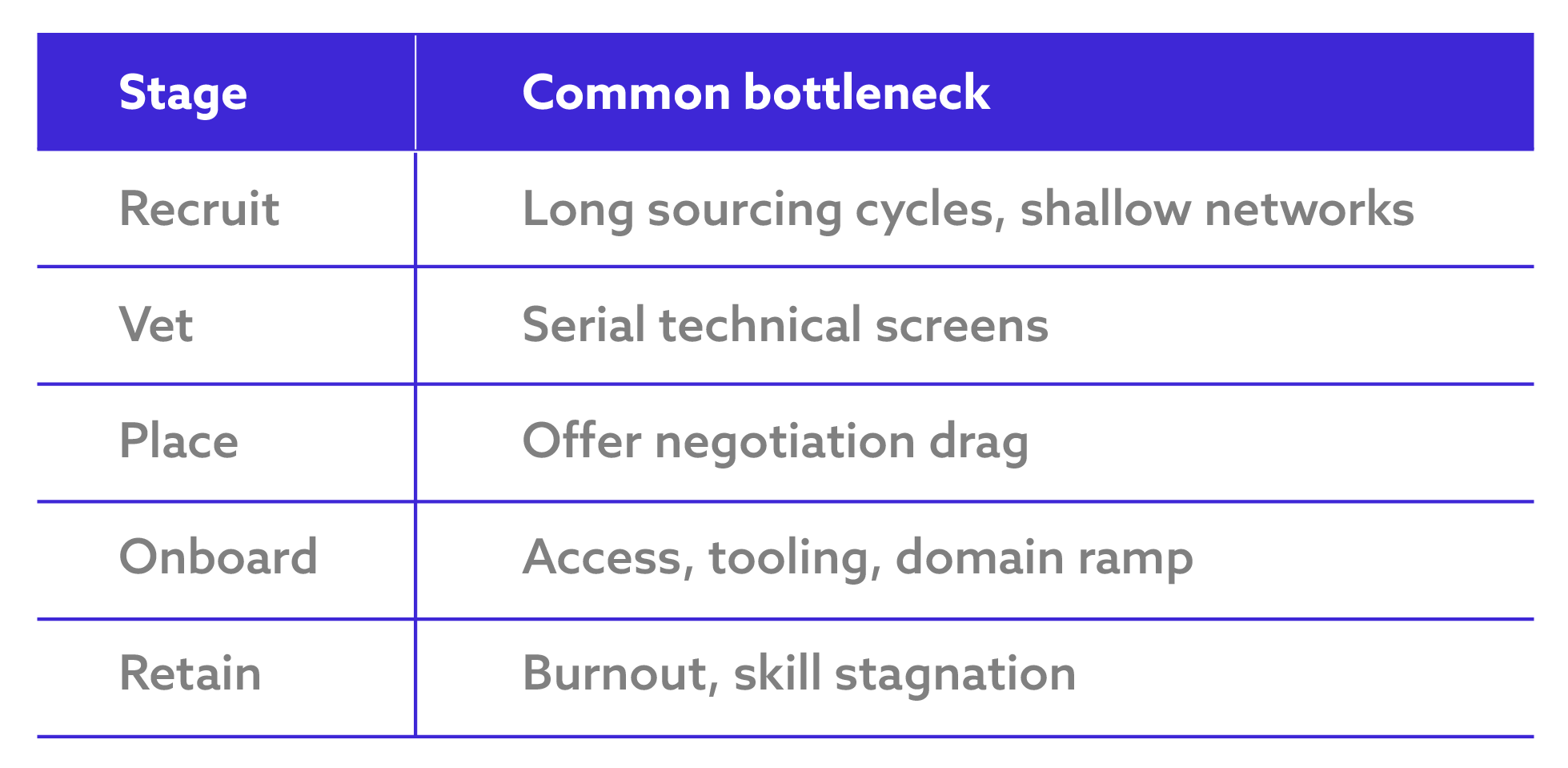Are Your Product Teams Falling Behind?

Here are 3 Critical Takeaways that will keep your Dev Teams on track – and save you costly missteps.
The average organization takes an average of 5½ months to hire one technical professional. Add 5 months to ramp that new hire to full productivity, and you’ve got 10+ months of lost velocity for one departed worker. Can your product roadmap afford to be stalled for a year as you search for, hire, and onboard a contributor? Multiply that across a growing team and your opportunity costs compound fast: missed deadlines, delays, and all the ground you’re giving up to competitors.
These are Lean Solutions Group’s (LSG’s) real-world benchmarks:
- 30 days to hire
- 3 to 5 weeks to fully ramp
- 97% retention rate
The delta between those two timelines is your talent velocity — the cumulative speed of every step from recruiting through retention. LSG partners with its clients to reduce talent velocity enabling our embedded employees to deliver results faster than industry averages.
Talent Velocity: Industry Average vs. Lean Solutions Group Actual

Product Roadmap Domino Effect
- $5.5 trillion of revenue will be lost worldwide by 2026, according to IDC.
- 54% of IT leaders say skill shortages have delayed product development, also according to IDC.
- 80% of teams face deployment delays averaging 3.8 months according to Gearset’s 2025 DevOps benchmark report.
When a key role is vacant for six months, what happens to your release cycles? Chances are, they’re blown. Filling a critical seat in 30 days instead of six months or longer can recover 80% of the throughput you would otherwise give up.
Sprint Velocity & Agile Flow
When your team’s headcount drops mid-sprint, the impact is immediate on user-story carryover, re-estimations, context-switching, and more. If it takes ten+ months to hire and ramp a team member, restoring capacity, that’s about 22 two-week sprints below target velocity! The top productivity blocker for 64% of development managers? “Inability to fill essential roles.”
Teams that protect their talent pipeline see the opposite effect. 31% of developers are more likely to improve delivery flow when related job vacancies are closed fast, according to Gartner.
Developer Experience as Velocity Insurance
Headcount stability is the quiet engine of sustained velocity. Gartner’s 2025 DevEx Benchmark finds a well-designed developer experience can lead to as much as a 20% increase in developer retention – and a 31% improvement in product delivery flow.
Here’s why culture, not just tooling, moves that needle:
- Burnout drives developer exits. In a survey of 500 engineering leaders and practitioners, 52% of respondents cited burnout as the reason their peers left their roles. When companies address the factors driving developer burnout, they’ll find fewer developers with “I’m done with this” job search tabs open.
- Growth-oriented cultures, where developers have clear career paths and structured skill development, are anchors for long-term commitment. Opportunities to learn are positively associated with engagement and negatively associated with burnout. Engagement is a top predictor of a developer’s intention to stay according to a 2024 study of 13,000 software professionals.
LSG pairs skills development pathways with a continuous improvement culture to achieve its 97% retention rate, demonstrating that as careers move forward, people move forward.
Talent Velocity Bottlenecks

LSG leverages near-shore and offshore talent with a structured process that squeezes each stage down to an efficient and precise minimum. This demonstrates how integrated process design can turn “speed hiring” into sustained capacity. By partnering with LSG, one client:
- Scaled from 4 to 27 developers in 6 months with 0 attrition
- Reduced average onboarding time to 26 days
- Achieved an average 9.44/10 employee engagement and productivity score
3 Critical Take-aways for Dev Teams
- Think pipeline, not patches. Recruitment speed matters – but so does everything else. When vetting, onboarding, and retention of workers are permitted to stretch the timeline, project deadlines will certainly slip.
- Quantify your vacancy costs. Map the average time-to-hire and ramp a new worker against desired sprint velocity and release cadence. The gap is usually bigger than it looks.
- Invest in improvements to the developer experience as a force-multiplier. Flow metrics improve when people have the bandwidth and teammates to keep work flowing.
Success isn’t just building teams faster. It’s securing, preparing, and retaining workers fast enough to keep work from slowing.
For faster talent velocity, contact LSG for a discovery call. Start building your talent advantage with global tech talent pools.
Ryan Mann loves building brands that stand out and tell a story. With a background in copywriting and marketing project management, he’s helped bring 12 award-winning branding, website, and video projects to life. In 2023, he was named a TMSA Top Brand Innovator for his work in supply chain marketing. He’s especially interested in how people and technology work together to shape the future of logistics—because at the end of the day, great marketing (and great supply chains) are all about connection.




